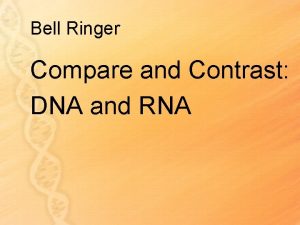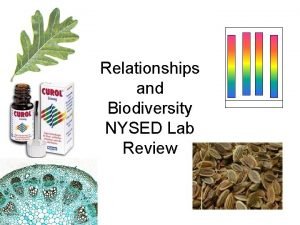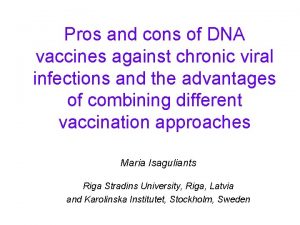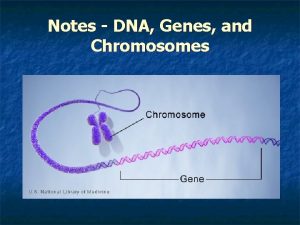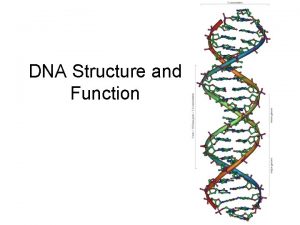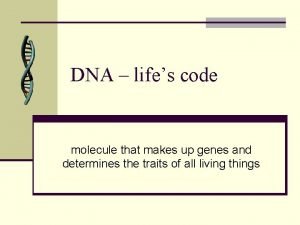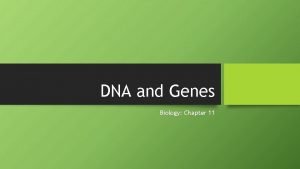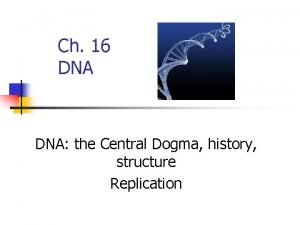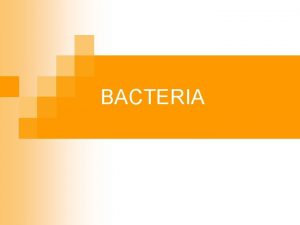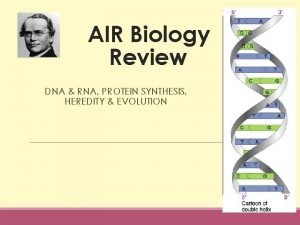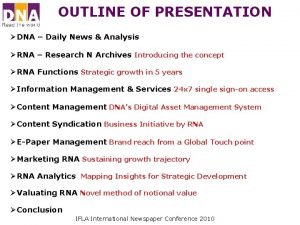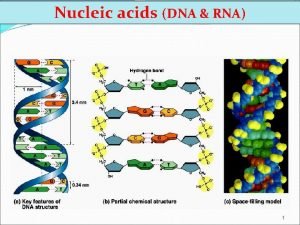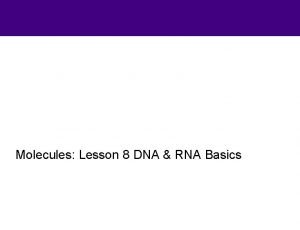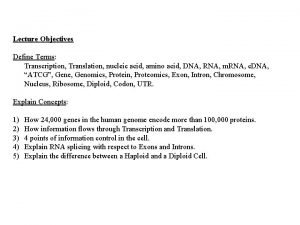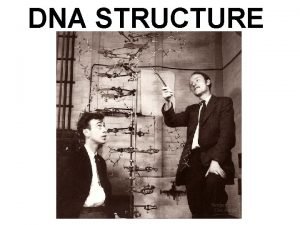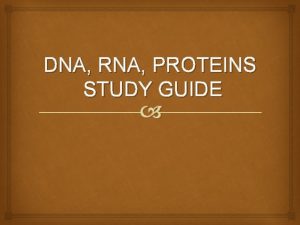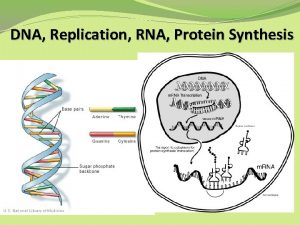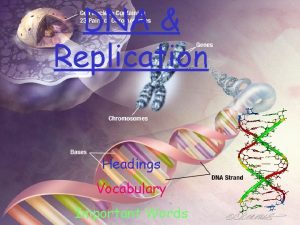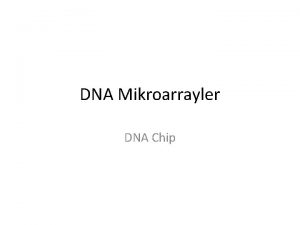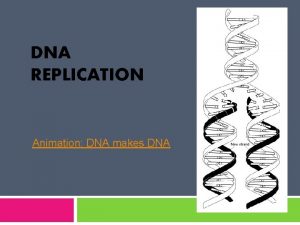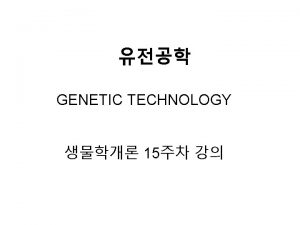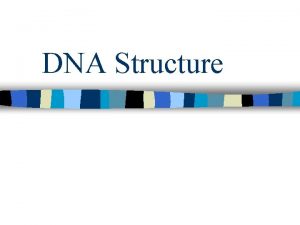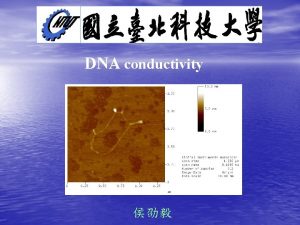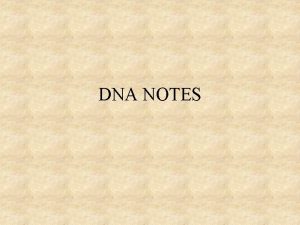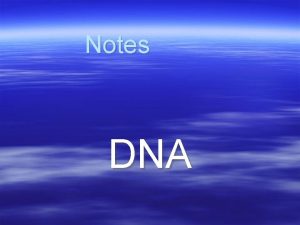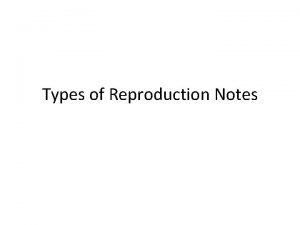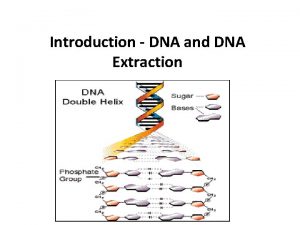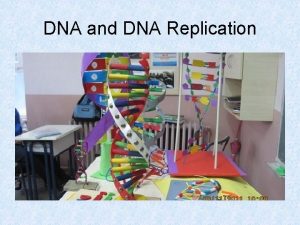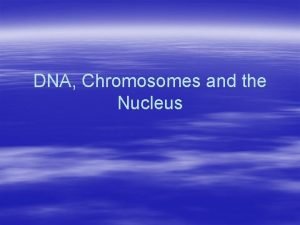Reproduction and DNA Notes I Reproduction a Reproduction




































- Slides: 36

Reproduction and DNA Notes

I. Reproduction a. Reproduction is the process by which an organism produces ______ others of the same kind. b. The two types of reproduction are sexual and _____. asexual _____

ØQuick Quiz ØName the 2 types of reproduction. ØSexual and asexual reproduction

II. Asexual Reproduction a. Asexual reproduction is when a single parent produces an ______ offspring that is genetically ______ identical to the ____. parent Fission _____ 1. _____, Budding and ________ Regeneration are types of asexual reproduction.

b. Fission is when a prokaryotic organism _______ divides into two ______ identical organisms. Bacteria reproduce 1. _____ asexually by fission.

Examples of Fission

c. Budding is when a new organism grows from the ______ parent body of the ____ organism. 1. When the _____ bud on the parent becomes large enough, it breaks away on its ____ own.

Examples of Budding

regeneration d. In ________ (fragmentation), a whole organism grows from just a part of the parent organism or can be used to _____ re-grow damaged or lost parts.

Examples of Regeneration

ØQuick ØWhat Quiz is asexual reproduction? ØWhen a parent makes an offspring identical to itself.

ØQuick ØWhat Quiz is fission? ØWhen a parent produces an organism identical to itself.

ØQuick ØWhat Quiz is budding? ØWhen a new organism grows from the body of the parent.

ØQuick Quiz ØProvide an example of an organism that undergoes regeneration? ØStarfish

III. Sexual Reproduction a. Sexual reproduction is when ______ sex cells (egg & sperm) from two parents _____ join together to produce an _____. offspring

1. _______ fertilization is when two sex cells, an egg & ____ sperm _____ come together. 2. The new cell that forms is called a zygote ____.

b. Sex cells are produced by a process called meiosis Meiosis _____. happens in the reproductive organs ________ of plants and animals.

c. Meiosis starts with one cell. There are two divisions of the _____ nucleus with ___ 4 sex cells produced, each containing ___ 23 chromosomes (in humans). http: //www. lewport. wnyric. org/jwanamaker/animations/meiosis. html Ø http: //www. pbs. org/wgbh/nova/baby/divi_flash. html Ø

ØQuick ØThe Quiz process that produces sex cells is called ______. Ømeiosis

ØQuick ØAt Quiz the end of meiosis, ______ sex cells are produced. Ø 4

ØQuick Quiz ØHow many chromosomes are in the human sex cells? Ø 23

IV. DNA (deoxyribonucleic acid) a. DNA is found in the nucleus of the cells. _____ genetic b. It is _____ material that holds information for the _______ the organism.

c. ________ Chromosomes are made of DNA molecules.

d. When a cell divides, DNA in the _____ copied and nucleus is ____ passed to the new cells.


e. Sometimes ______ mistakes happen when DNA is copied. This is called a _____. mutation Ultraviolet light, nuclear radiation, and certain chemicals can damage DNA by altering nucleotide bases so that they look like other bases.

1. Mutations can cause changes in traits ______. Some changes are _____, harmful helpful and some are ____ some don’t help or hurt the organism. 2. Mutations in sex cells can offspring be ____ passed on to _____.

ØQuick Quiz ØChromosomes are made up of _____. ØDNA

ØQuick Quiz ØMutations in sex cells can be passed on to the ______. ØOffspring

f. The DNA molecules are made strands up of two twisted _____ connected together by ______ chemical bonds.

1. The DNA structure resembles a twisted ladder ____.

2. The sides of the DNA “ladder” are sugar made of the _______ deoxyribose and phosphate molecules. 3. The “rungs” of the DNA “ladder” are made of the bases nitrogen __________ adenine, thymine, cytosine & _____ guanine.

ØQuick ØThe Quiz DNA structure looks like a _____________. ØTwisted ladder

ØQuick ØThe Quuiz sides of the ladder are made of _______. ØSugar (deoxyribose) and phosphate molecules

ØQuick ØThe Quiz steps (rungs) of the ladder are made of __________. ØNitrogen bases

ØQuick ØName Quiz the 4 bases. ØAdenine, thymine, cytosine and guanine
 Coding dna and non coding dna
Coding dna and non coding dna Asexualk
Asexualk Replication fork
Replication fork Bioflix activity dna replication lagging strand synthesis
Bioflix activity dna replication lagging strand synthesis What role does dna polymerase play in copying dna?
What role does dna polymerase play in copying dna? Dna rna protein synthesis homework #2 dna replication
Dna rna protein synthesis homework #2 dna replication The disadvantages of sexual reproduction
The disadvantages of sexual reproduction Sexual and asexual reproduction venn diagram
Sexual and asexual reproduction venn diagram Nucleotide excision repair
Nucleotide excision repair Wisc
Wisc Rna transfer
Rna transfer Dna rna venn diagram
Dna rna venn diagram Vce hhd study design
Vce hhd study design Haploid vs diploid
Haploid vs diploid Transcription end result
Transcription end result Relationships and biodiversity state lab answers
Relationships and biodiversity state lab answers Dna vaccines pros and cons
Dna vaccines pros and cons Dna, genes and chromosomes relationship
Dna, genes and chromosomes relationship Dna polymerase proofreading
Dna polymerase proofreading Dna structure and replication packet answer key
Dna structure and replication packet answer key Dna polymer and monomer
Dna polymer and monomer What is the goal of replication
What is the goal of replication Chapter 11 dna and genes
Chapter 11 dna and genes What does 5' and 3' mean in dna
What does 5' and 3' mean in dna Complete the following venn diagram
Complete the following venn diagram Picking up and incorporating dna from dead bacterial cells
Picking up and incorporating dna from dead bacterial cells Dna and rna coloring worksheet
Dna and rna coloring worksheet Protein synthesis
Protein synthesis Dna daily news analysis
Dna daily news analysis Dna and rna
Dna and rna Dna and rna
Dna and rna Dna transcription and translation
Dna transcription and translation What does 3 and 5 mean in dna
What does 3 and 5 mean in dna Dna rna and proteins study guide answers
Dna rna and proteins study guide answers Difference between dna and rna extraction
Difference between dna and rna extraction Lenine
Lenine Building vocabulary: the nucleus, dna, and chromosomes
Building vocabulary: the nucleus, dna, and chromosomes










